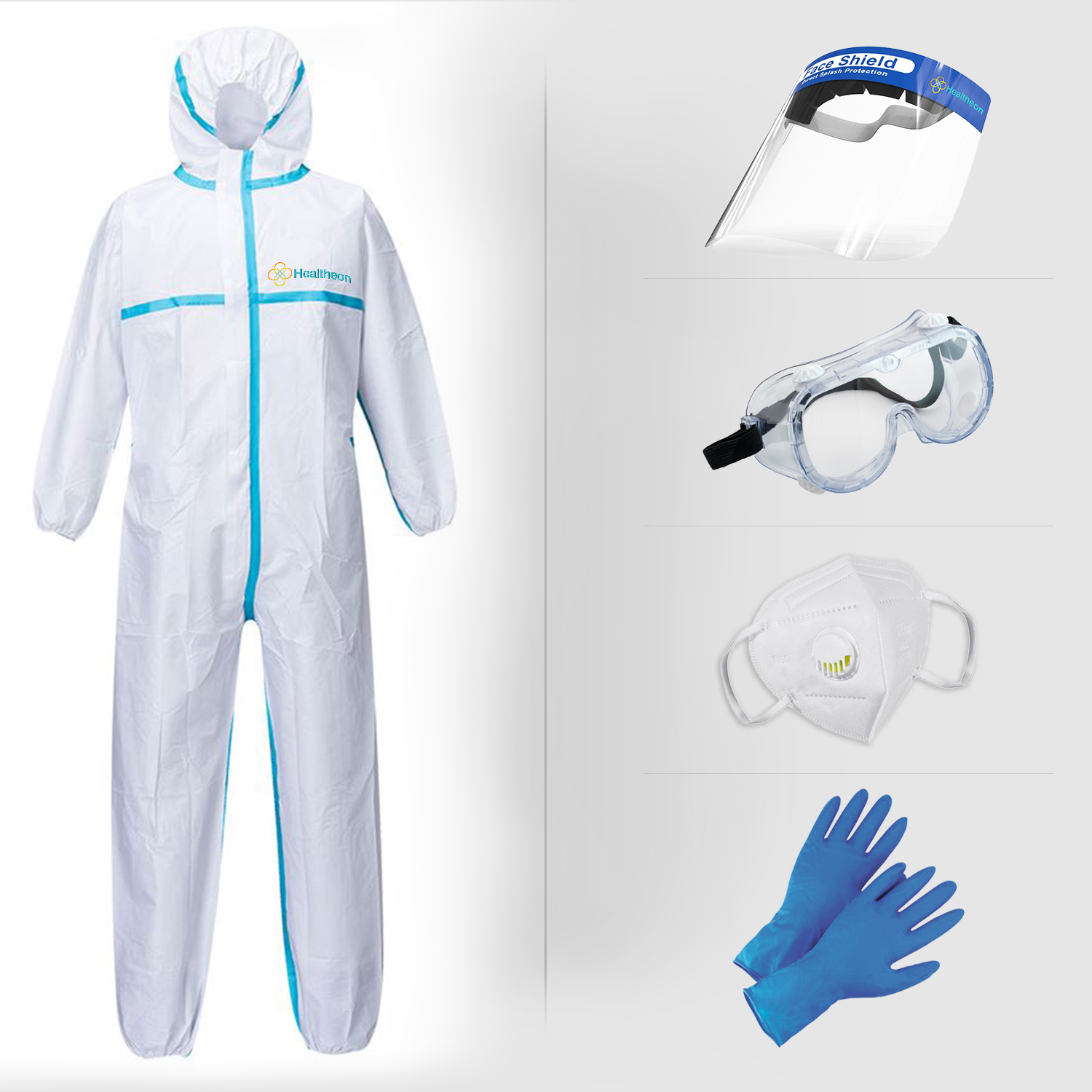Overview














- DRDO Certified ISO 16603 Class 3 - Passed with Class 6
- SSMMS 65 GSM for best breathability and comfortable use Taped for extra protection at Seams
- All other accessories are certified as per standards requirement
Details
- Personal Protective Equipment (PPE): Personal Protective Equipments (PPEs) are protective gears designed to safeguard the health of workers by minimizing the exposure to a biological agent.
- Components of PPE : Components of PPE are goggles, face-shield, mask, gloves, coverall/gowns (with or without aprons), head cover and shoe cover. Each component and rationale for its use is given in the following paragraphs:
- Face shield and goggles: Contamination of mucous membranes of the eyes, nose and mouth is likely in a scenario of droplets generated by cough, sneeze of an infected person or during aerosol generating procedures carried out in a clinical setting. Inadvertently touching the eyes/nose/mouth with a contaminated hand is another likely scenario. Hence protection of the mucous membranes of the eyes/nose/mouth by using face shields/ goggles is an integral part of standard and contact precautions. The flexible frame of goggles should provide good seal with the skin of the face, covering the eyes and the surrounding areas and even accommodating for prescription glasses.
-
Masks : Respiratory viruses that includes Coronaviruses target mainly the upper and lower respiratory tracts. Hence protecting the airway from the particulate matter generated by droplets / aerosols prevents human infection. Contamination of mucous membranes of the mouth and nose by infective droplets or through a contaminated hand also allows the virus to enter the host. Hence the droplet precautions/airborne precautions using masks are crucial while dealing with a suspect or confirmed case of COVID-19/performing aerosol generating procedures. Masks are of different types. The type of mask to be used is related to particular risk profile of the category of personnel and his/her work. There are two types of masks which are recommended for various categories of personnel working in hospital or community settings, depending upon the work environment:
- Triple layer medical mask
- N-95 Respirator mask
- Triple layer medical mask: A triple layer medical mask is a disposable mask, fluid-resistant, provide protection to the wearer from droplets of infectious material emitted during coughing/sneezing/talking.
- N-95 Respirator mask: An N-95 respirator mask is a respiratory protective device with high filtration efficiency to airborne particles. To provide the requisite air seal to the wearer, such masks are designed to achieve a very close facial fit. Such mask should have high fluid resistance, good breathability (preferably with an expiratory valve), clearly identifiable internal and external faces, duckbill/cup-shaped structured design that does not collapse against the mouth. If correctly worn, the filtration capacity of these masks exceeds those of triple layer medical masks. Since these provide a much tighter air seal than triple layer medical masks, they are designed to protect the wearer from inhaling airborne particles.
- Gloves: When a person touches an object/surface contaminated by COVID-19 infected person, and then touches his own eyes, nose, or mouth, he may get exposed to the virus. Although this is not thought to be a predominant mode of transmission, care should be exercised while handling objects/surface potentially contaminated by suspect/confirmed cases of COVID-19. Nitrile gloves are preferred over latex gloves because they resist chemicals, including certain disinfectants such as chlorine. There is a high rate of allergies to latex and contact allergic dermatitis among health workers. However, if nitrile gloves are not available, latex gloves can be used. Nonpowdered gloves are preferred to powdered gloves.
- Coverall/Gowns : Coverall/gowns are designed to protect torso of healthcare providers from exposure to virus. Although coveralls typically provide 360-degree protection because they are designed to cover the whole body, including back and lower legs and sometimes head and feet as well, the design of medical/isolation gowns do not provide continuous whole-body protection (e.g., possible openings in the back, coverage to the mid-calf only). By using appropriate protective clothing, it is possible to create a barrier to eliminate or reduce contact and droplet exposure, both known to transmit COVID-19, thus protecting healthcare workers working in close proximity (within 1 meter) of suspect/confirmed COVID-19 cases or their secretions. Coveralls and gowns are deemed equally acceptable as there is a lack of comparative evidence to show whether one is more effective than the other in reducing transmission to health workers. Gowns are considerably easier to put on and for removal. An apron can also be worn over the gown for the entire time the health worker is in the treatment area. Coveralls/gowns have stringent standards that extend from preventing exposure to biologically contaminated solid particles to protecting from chemical hazards.
- Shoe covers : Shoe covers should be made up of impermeable fabric to be used over shoes to facilitate personal protection and decontamination.
- Head covers : Coveralls usually cover the head. Those using gowns, should use a head cover that covers the head and neck while providing clinical care for patients. Hair and hair extensions should fit inside the head cover.
Large Volume Order
All fields are required unless indicated optional
